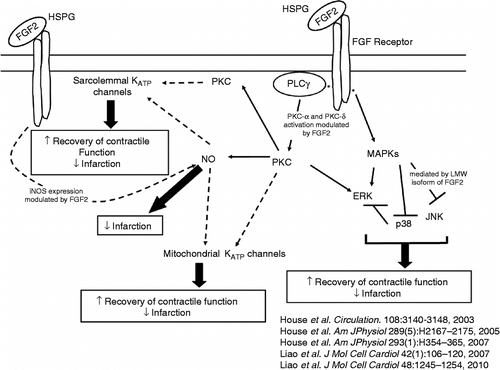By Manning et al. published in Growth Factors 2012;30:124–139 (DOI: 10.3109/08977194.2012.656759)
Following publication of this article, an error has been identified in Figure 8. The arrows for “infarction” should be facing downwards indicating that infarct size is decreased by mitochondrial KATP channels.
The correct is shown below.
Figure 8. Schematic depicting the intracellular signaling network of endogenous FGF2-induced cardioprotection against cardiac dysfunction and myocardial infarction. Our laboratory previously demonstrated that endogenously expressed FGF2 in heart resulted in cardioprotection (House et al. 2003; Liao et al. 2007, 2010) via PKC and ERK activation (House et al. 2005) and p38 (House et al. 2005) as well as JNK inhibition (Liao et al. 2007). This protein kinase activation or inhibition was modulated by cross-talk between PKC and MAPKs (House et al. 2005; House et al. 2007). Our recent data demonstrate an involvement of NO and KATP channels, directly or indirectly, to enhance post-ischemic recovery of cardiac function and/or reduce infarct size elicited by endogenous FGF2. Solid line indicates documented involvement of signaling cascade. Dashed line indicates potential pathway of protection. Upward arrow indicates improvement in recovery of post-ischemic contractile function and downward arrow indicates a reduction in infarct size.

